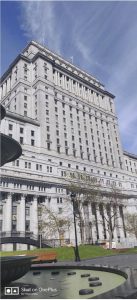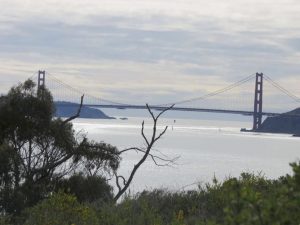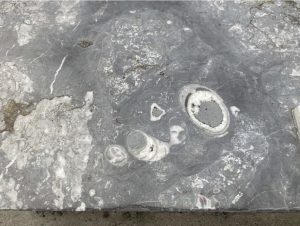It is quite an understatement to say that the COVID-19 pandemic of 2020 disrupted our lives. As a field-based researcher, I had to cancel all my fieldwork activities and instead embrace the lifestyle that I clearly wanted to avoid when I started on my career track: sit at a desk and stare at a screen. But when life gives you a ton of lemons, you learn to make gallons of lemonade. So here is how I turned the lemons into some sweet, cold lemonade.

Sunlife Building in downtown Montreal made out of Stanstead Granite
I used my COVID-19 isolation period to create virtual field trip guides for urban geology of Montreal, in association with the Redpath Museum of Natural History, my supervisor Dr. Christie Rowe, and the Department of Earth & Planetary Sciences, McGill University. Before we jump into what the virtual field trips are, let me introduce you to the concept of virtual field trips and what got me interested in them.

View from Meghomita’s campsite at Angel Island
Geologists love field trips. It acts like a paid vacation trip, except that it is actually our work and we get to geek out over rocks in the great outdoors. Every conference within the Earth Sciences community features a significant field trip section. However, at times, it is difficult to attend all such trips. Each trip is expensive, clashes with our schedules, and has accessibility issues that bars a significant population of geoscience researchers from attending these trips. Enter Virtual Field Trips. Virtual field trips provide you with the opportunity to explore all the cool places around the world from the seat of your couch. You can do these trips in your own time, from the comfort of your home, and at times, it is free. They serve as excellent learning resources for teachers who want to share the mysteries of the great outdoors with their students but are limited by the resources available to them. For some, these field trips act as a teaser trailer for the actual in-person trip.
In December 2019, a band of geologists got together and created a virtual field trip guide called “Streetcar to Subduction”. This was presented at the American Geophysical Union’s Annual Meeting, held in San Francisco, USA. They wanted to create a virtual version of a field guide book called “ A streetcar to subduction and other Plate Tectonic trips by public transport in San Francisco” by Clyde Wahrhaftig, published back in the ‘80s. This guidebook featured 7 trips, in and around San Francisco, and showcased the cool geological outcrops that the state of California is blessed with. You could catch a glimpse of a really big, naturally reflective mirror surface close to the Mint Building that was an ancient fault zone or you could get a glimpse of the motion of tectonic plates by observing two sidewalk blocks sliding past each other at a gas station in East Bay. All these field trips are hosted on Google Earth. You can access these trips using any mobile device. Each trip contains a host of pictures, videos, and other illustrations that beautifully explains each location’s main geologic feature. All information regarding how to get there, nearest parking locations, safe trail routes are also mentioned for each stop.

Fossil Muesem
This project fueled a new rush for more virtual field trip guides and thus, a band of geologists at McGill University and Polytechnique Montreal got together to create a new series of field trip guides called “Metro to Monteregie”, an homage to the Monteregian Hills that crop out along southern Quebec, Canada. We were hoping to launch these guides as part of the Geological Society of America’s Annual Fall meeting that was going to be held in Montreal, Canada this year. Enter COVID-19 (the devil!). Even though the meeting shifted to a virtual platform, we decided to launch this project during the conference and showcase the features of these trips to the virtual audience.
I am currently leading one of the field trips in this project: Building Stones of Montreal. This trip is a mish-mash of historic building construction, cultural significance, architectural styles over the centuries, and of course, my beloved rocks and fossils. We will be exploring a few of the historic buildings in the downtown area of Montreal. At each location, we will talk about the building stone that was used in the construction, how it was quarried, the architect’s stylistic choices, and most importantly, how the rock came into existence. At some location, we will even go fossil hunting and get a sneak peek into the animal’s living conditions, way back in the day (read: hundreds of millions of years ago!). This field trip is an extension of the Redpath Museum’s publication “What Building Stones Tell”. Some of the other trips that will be showcased in the Metro to Monteregie project include Mont-Royal (the hill that gives Montreal its name and part of the Monteregie Hills), Mont Saint Hilaire (another hill in the Monteregie system), a general overview of Montreal and its geology. These trips will be available in French and English and will be shared as teaching resources for schools around Quebec.
While I was creating this trip back in spring 2020, I developed a habit of taking a lot of socially-distanced walks around my neighborhood to clear my head and breathe in the beautiful fresh spring air. I called them my COVID walks. I figured that there must be others like me who would like to take these walks and admire what is present all around us: rocks, and tons of it. With this in mind, my colleague Ingrid Birker and I decided to launch a Fossil Exploration Guide of Montreal for a more family audience. This trip showcases the diversity of fossils that exist all around us. It takes you around Downtown Montreal and at each location, you get a small blurb about the fossil, its age, and its closest living relative. It was built on an ArcGIS StoryMaps platform and was launched during the Virtual Homecoming 2020 at McGill University, in association with my department and Redpath Museum.
As the global pandemic slides into what seems like the millionth year, these virtual field trip guides provide a platform where we can visit places far away from us and learn about the local geology while we huddle up with our loved ones. These trips are free, easily accessible, and they will exist forever in cyberspace so that you can check it out whenever you feel the tangs of wanderlust. As I type this article, sitting at my desk and staring at my screen, I am dreaming about the future where I can go out to my field site and be united with my beloved rocks. But until then, these virtual field trip tours seem like the way to do field visits in the times of COVID-19. Would you like to join me?
Written by Meghomita Das
Links & Resources:
These trips were developed from the perspective of geoscientists. However, these trips can be easily modified to showcase the local flora, fauna, and any other discipline that incorporates field research.
AGU S2S: https://www.agu.org/learn-and-develop/learn/streetcar2subduction/streetcar2subduction
ArcGIS Fossil Exploration tour: https://arcg.is/10q58u
If you would like to know more about how I developed these trips and would like to create one for your city, feel free to reach out to me meghomita.das@mail.mcgill.ca or @meghomita on Twitter.